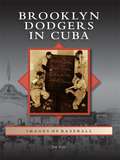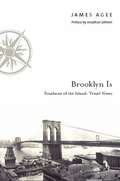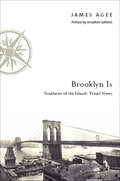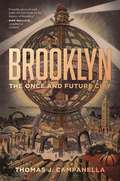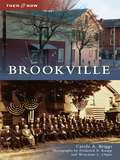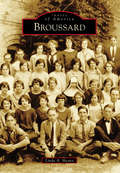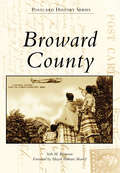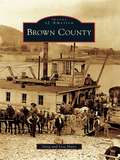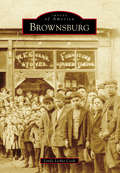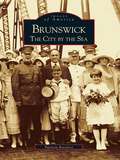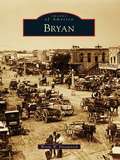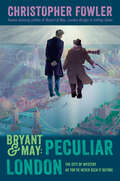- Table View
- List View
Brooklyn Dodgers (Images of Sports)
by Mark RuckerIf there was ever a place in America where a city and its baseball team were as close as family, it was Brooklyn. The legacy of this relationship comes down to us in stories of childhoods spent at Ebbets Field and in the stories of Jackie Robinson and Branch Rickey, whose courage changed the face of America. Baseball in Brooklyn goes back to the beginning of the sport, when a young city embraced a new game and, like missionaries, carried it to the nation. This book tells the story of that beginning and concludes with the heart-wrenching move of the franchise to the West Coast after the 1957 season. Brooklyn Dodgers carries us from the birth of baseball in the streets of Brooklyn through the decades in Flatbush when Ebbets Field was the center of the Brooklyn community. That was a time when the players lived in the neighborhoods not far from the ballpark, side by side with their followers. Duke Snider, Pee Wee Reese, Jackie Robinson, Gil Hodges, and Johnny Podres all make appearances in this exciting selection of photographs. A large part of Brooklyn Dodgers is dedicated to those teams of the 1950s and their irrepressible fans.
Brooklyn Dodgers in Cuba (Images of Baseball)
by Jim VittiThe Brooklyn Dodgers held spring training in Havana in 1947 so Jackie Robinson could practice safely. <P><P>Yet that was hardly the beginning: the Bums played in Cuba over 60 seasons, from 1900 to 1959. Ballplayers drank hard with Hemingway. Some found themselves in Cuban jails. Pitcher Van Lingle Mungo, barricaded in the Hotel Nacional with two women, fended off an angry husband (and his machete). Leo Durocher got into a brawl with an umpire, after Lippy's translator correctly cursed him in Spanish. Vin Scully watched machine gun-toting barbudas enter the room. An outfielder leaped into the stands, with a loaded gun, to chase a fan. <P><P>Several players encountered Castro, who once walked onto the field in his fatigues, patted his pistol, and said to Lefty Locklin, "Tonight, we win."
Brooklyn Is -- Southeast of the Island: Travel Notes
by James Agee Jonathan LethemIn 1939, James Agee was working for Fortune magazine. Commissioned to write an article on Brooklyn for a special issue on New York, Agee moved to the Flatbush neighborhood for two months, later producing "Southeast of the Island: Travel Notes". As had earlier happened with the essay that was to become his classic portrait of southern farmers, "Let Us Now Praise Famous Men", Fortune declined to publish, and the essay remained unpublished until its 1968 Esquire appearance under the title "Brooklyn Is". In the words of Brooklyn-born novelist Jonathan Lethem, who provides the introduction to the essay in this volume, "the narrative rises up on the swirling imaged-junked cone of Agee's prophetic style to see the borough and its people whole".
Brooklyn Is: Travel Notes
by James Agee Jonathan LethemFor the first time in book form—a great writer’s classic celebration of the essence of Brooklyn. In 1939, James Agee was assigned to write an article on Brooklyn for a special issue of Fortune on New York City. The draft was rejected for “creative differences,” and remained unpublished until it appeared in Esquire in 1968 under the title “Southeast of the Island: Travel Notes.” Crossing the borough from the brownstone heights over the Brooklyn Bridge out through backstreet neighborhoods like Flatbush, Midwood, and Sheepshead Bay that roll silently to the sea, Agee captured in 10,000 remarkable words, the essence of a place and its people. Propulsive, lyrical, jazzy, and tender, its pitch-perfect descriptions endure even as Brooklyn changes; Agee’s essay is a New York classic. Resonant with the rhythms of Hart Crane, Walt Whitman, and Thomas Wolfe, it takes its place alongside Alfred Kazin’s A Walker in the City as a great writer’s love-song to Brooklyn and alongside E. B. White’s Here Is New York as an essential statement of the place so many call home. James Agee was born in Knoxville, Tennessee, in 1909. One of the great prose stylists of the past century, Agee wrote in many forms—poetry, short stories, novels, essays, commentary, and criticism. In 1958 he won the Pulitzer Prize for fiction for A Death in the Family, and he also wrote the classic account of poor Southern farmers, Let Us Now Praise Famous Men, accompanied by Walker Evans’s documentary photographs. With John Huston, he wrote the Oscar-nominated screenplay for The African Queen, and he was an influential film and theater critic for Time and The Nation. James Agee died in 1955 of a heart attack in a New York City taxicab. In the fall of 2005, the Library of America will publish a two-volume collection of his writings. Jonathan Lethem’s novels include Fortress of Solitude and Motherless Brooklyn, which won the National Book Critics Circle Award, his most recent book is The Disappointment Artist. Lethem was born and raised in Brooklyn, where he still lives.
Brooklyn Noir 3: Nothing But the Truth (Akashic Noir #3)
by Tim Mcloughlin Thomas AdcockAkashic Books continues its award-winning series of original noir anthologies, launched in 2004 with Brooklyn Noir. This volume presents the first nonfiction collection in the series, curated by acclaimed novelists Tim McLoughlin and Thomas Adcock.Brand-new stories by: Robert Leuci, Dennis Hawkins, Tim McLoughlin, Thomas Adcock, Errol Louis, Denise Buffa, Patricia Mulcahy, C.J. Sullivan, Reed Farrel Coleman, Aileen Gallagher, Christopher Musella, Kim Sykes, Robert Knightly, Jess Korman, Constance Casey, and Rosemarie Yu."There is a difference, as editor, between cheering the literary accomplishment of a fiction writer who has delivered a brilliant story about a serial killer or hit man, and reading the true account, however beautifully written, of a young woman raped, murdered, and forgotten. So this book, though it has its light moments (and thank God for those), is for me the darkest of the Brooklyn Noir series. These pieces remind us that crime is personal. It happens to us and to our neighbors. Sometimes it happens because we do nothing to prevent it. Life does not always offer the moral arc we so desperately crave in fiction. If it did, we'd have no need for myths and fables, religion or miracles . . ."Read this book. Enjoy it. Be horrified by it. Carry it with you always. And the next time you're watching a particularly bizarre and salacious news item on the television set in your neighborhood pub, and the guy on the next stool says, "You can't make this shit up," smack him with it."--Tim McLoughlin, from the introduction
Brooklyn: The Once and Future City
by Thomas CampanellaAn unprecedented history of Brooklyn, told through its places, buildings, and the people who made them, from the early seventeenth century to todayAmerica's most storied urban underdog, Brooklyn has become an internationally recognized brand in recent decades—celebrated and scorned as one of the hippest destinations in the world. In Brooklyn: The Once and Future City, Thomas J. Campanella unearths long-lost threads of the urban past, telling the rich history of the rise, fall, and reinvention of one of the world’s most resurgent cities.Spanning centuries and neighborhoods, Brooklyn-born Campanella recounts the creation of places familiar and long forgotten, both built and never realized, bringing to life the individuals whose dreams, visions, rackets, and schemes forged the city we know today. He takes us through Brooklyn’s history as homeland of the Leni Lenape and its transformation by Dutch colonists into a dense slaveholding region. We learn about English émigré Deborah Moody, whose town of Gravesend was the first founded by a woman in America. We see how wanderlusting Yale dropout Frederick Law Olmsted used Prospect Park to anchor an open space system that was to reach back to Manhattan. And we witness Brooklyn’s emergence as a playland of racetracks and amusement parks celebrated around the world.Campanella also describes Brooklyn’s outsized failures, from Samuel Friede’s bid to erect the world’s tallest building to the long struggle to make Jamaica Bay the world’s largest deepwater seaport, and the star-crossed urban renewal, public housing, and highway projects that battered the borough in the postwar era. Campanella reveals how this immigrant Promised Land drew millions, fell victim to its own social anxieties, and yet proved resilient enough to reawaken as a multicultural powerhouse and global symbol of urban vitality.
Brookville
by Wrayanne L. Clapie Carole A. Briggs Frederick E. KnappBrookville photographer Frederick E. Knapp documented the events, people, and places of Brookville, the seat of Jefferson County, between 1898 and 1945. Teacher and amateur photographer Wrayanne L. Clapie revisited those sites in 2008. Now a federally registered historic district, Brookville's Main Street buildings, businesses and industries, schools, churches, and homes typify architecture during the last part of the 19th century and life during the first half of the 20th century, illustrating both change and preservation.
Brookville
by Craig T. Chappelow Donald L. DunawayPlatted in 1808 on a strip of land between the confluence of the East and West Forks of the Whitewater River, Brookville is one of the oldest and most picturesque towns in Indiana. The authors have assembled more than 200 historic postcards, contributed by local residents and collectors, that tell the story of Brookville's people and places. Many of the scenes depicted in Brookville postcards show homes, busy factories, and rural scenes that have long since disappeared. Browsing through these images gives an indication of the way Brookville used to be. Others scenes are easily recognizable today and show how the citizens of the town have preserved some of its most important landmarks.
Brother Mendel's Perfect Horse: Man and beast in an age of human warfare
by Frank Westerman' "When you touch a Lipizzaner, you're touching history," Westerman was once told. His elegant book offers fascinating proof' Financial Times Frank Westerman explores the history of Lipizzaners, an extraordinary troop of pedigree horses bred as personal mounts for the Emperor of Austria-Hungary. Following the bloodlines of the stud book, he reconstructs the story of four generations of imperial steed as they survive the fall of the Habsburg Empire, two world wars and the insane breeding experiments conducted under Hitler, Stalin and Ceausescu. But what begins as a fairytale becomes a chronicle of the quest for racial purity. Carrying the reader across Europe, from imperial stables and stud farms to the controversial gene labs of today, Westerman asks, if animal breeders are so good at genetic engineering, why do attempts to perfect the human strain always end in tragedy?
Broussard (Images of America)
by Linda A. MeauxAs early as 1765, Acadians began to settle near St. Martinville in the center of an area known as Côte Gelée, or "Frozen Hill," due to seasonal cold temperatures that covered the Mississippi River with ice. These early settlers were exiles from Acadie (now Nova Scotia, Canada). They established farms that, in the early 1800s, became interspersed among expanding sugar plantations. With a motto of "Where our rich culture defines us," Broussard is one of the fastest growing cities in Louisiana today. Embracing its past has made way for Broussard's competitive spirit that positions its leaders in not only the state, but also the world. The Billeaud Sugar Mill, which supported the community for many years, has now diversified into land acquisitions. The St. Julien families, identified for many generations with agricultural, professional, and political interests, have long-standing ties to the community, as do sports figures such as National League umpire Greg Bonin and two Blanchard siblings who competed in the Junior Olympics.
Broward County: For More Than Ninety Years Broward County's City Of Choice (Postcard History Series)
by Seth H. Bramson Mayor Barbara ShariefBroward County came into existence on October 1, 1915, when Dade and Palm Beach Counties were partitioned to form a new county. Named for early-20th-century Florida governor Napoleon Bonaparte Broward, the county has grown to become renowned for nationally acclaimed restaurants, residential areas, colleges, universities, and shopping along Las Olas Boulevard in Fort Lauderdale. A major American metropolitan area, Broward County today is home to a branch of Florida International University, as well as the campuses of Nova Southeastern University, Broward College, and Florida Atlantic University. As of 2016, the population of Broward County was approximately 1.8 million people, making it Florida�s second-most populous county and the 17th-most populous in the United States.
Broward County: The Photography of Gene Hyde
by Susan GillisIn 1915, the South Florida communities of Fort Lauderdale, Dania, Pompano, Hallandale, Deerfield, and Davie joined together to form a county. They named it Broward, in honor of the governor whose Everglades drainage program had brought them such prosperity. Today, Broward is Florida's second largest county, with 1.6 million people. Photographer Aaron Eugene Hyde came to Fort Lauderdale in 1933, at the age of 16, to begin a 40-year career, serving as one of the county's few professional photographers and the photographer for the Broward edition of the Miami Herald. Gene recorded fascinating people, places, and times pivotal in the county's development. His photos evoke nostalgia for the not-that-distant past, a way of life Broward County residents will never see again.
Brown Bears in Alaska's National Parks: Conservation of a Wilderness Icon
by Grant V. Hilderbrand Kyle Joly David D. Gustine Nina ChambersBrown bears are powerful symbols of wilderness, thriving in the vast, untamed ecosystems of Alaska’s remote national parks. Brown Bears in Alaska’s National Parks is a unique and thorough exploration of the conservation, ecology, and management of brown bears in these parks, including examinations of bear biology, human-bear interactions, population estimation methods, and the effects of climate change on bear populations. This lavishly illustrated volume offers fresh perspectives about the complex challenges that bears and humans face as they navigate coexistence in the evolving wilderness of Alaska. Through park-specific chapters, the authors clearly present the current understanding of brown bear ecology across a wide range of ecosystems—from the sparse and frigid Gates of the Arctic, entirely above the Arctic Circle, to the bountiful coast of Katmai, where the marine and terrestrial systems converge. In Glacier Bay, bears roam newly exposed ecosystems shaped by retreating glaciers, while the interior landscapes of Lake Clark and Denali provide a mix of boreal forests, tundra, rivers, and towering mountains. Brown bears—and the many species that share their habitats—face numerous challenges, with climate change among the greatest threats. The warming climate intensifies other pressures, such as industrial development, both within and around park boundaries. Management actions may also reduce native brown bear populations and, in turn, threaten healthy and naturally functioning ecosystems. The adaptability of brown bears, in concert with thoughtful and science-based management, is essential for the conservation of these majestic creatures and the wilderness landscapes on which they depend. Written by the wildlife biologists and anthropologists who have dedicated their careers to studying brown (grizzly) bears and their relationship to people, Brown Bears in Alaska’s National Parks is a premier reference for bear enthusiasts, biologists, managers, and academics, as well as advocates for wild things and wild places.
Brown County
by Lisa Haitz Greg HaitzThe history of Brown County has been shaped largely by the Ohio River. It has allowed farmers and industries to transport their products and provided recreation, entertainment, and travel opportunities to the residents of the community. Even though flooding of the river brought destruction many times, it also enabled freedom for thousands of slaves. Under abolitionist leaders like John Rankin and John Parker, parts of Brown County became known as the "Grand Central Station" of the Underground Railroad. Interesting and notable Brown County natives include Ulysses S. Grant, who grew up to command one of the largest armies ever assembled and later became president of the United States; Col. Charles Young, the third African American to graduate from West Point and a military attache to Liberia; Rosie Riles, better known as "Aunt Jemima"; and Joe Smith, who inadvertently helped Louis Armstrong's career, also hailed from this great county.
Browns Mills
by Marie F. ReynoldsHalfway between the bustling streets of Philadelphia and the serenity of the New Jersey Shore lies Browns Mills, New Jersey. Nestled within its rich pine trees and dark lakes is the legacy of those who sought nature's healing properties, social status, and a summer refuge for more than two generations.Their stories and faces make up the exciting collection in Browns Mills. Tales of those who came seeking natural spring waters to avoid le grippe became the foundation for the grand hotels that existed in the early nineteenth century. The annals of others in search of a lakefront lot as their own private hideaway create the framework for a modern town that remains dotted with quaint summer cottages.Their stories, at last, are combined in Browns Mills to form a chronicle of life in this Pinelands community from 1820 through the 1970s.
Brownsburg (Images of America)
by Linda Lichte CookIn 1835, William Harris sectioned off his land--the area now known as Main and Green Streets in Brownsburg--for the purpose of establishing a town. Harris used beech trees, elm trees, and hickory stumps to define the town's boundaries; he called it Harrisburg. The name Harrisburg was already in use elsewhere in Indiana, so Brownsburg, which paid homage to early settler James B. Brown, was selected as an alternative. Brownsburg's railroad station, located between Indianapolis and Crawfordsville, positioned the farming community for dramatic growth. As new settlers arrived, new businesses, mills, and factories also began to open. Today, Brownsburg continues to grow, and the community is known for its engineering and racing industries and its first-rate schools.
Brunetti's Venice: Walks with the City's Best-Loved Detective
by Toni SepedaAn armchair traveler&’s companion to Donna Leon&’s Brunetti mysteries: &“a splendid present for mystery-fiction fans [or] travel-lit buffs&” (Tom Nolan, The Wall Street Journal). Follow Commissario Guido Brunetti, star of Donna Leon&’s international bestselling mystery series, on over a dozen walks that highlight Venice&’s churches, markets, bars, cafes, and palazzos. In Brunetti&’s Venice, tourists and armchair travelers follow in the footsteps of Brunetti as he traverses the city he knows and loves. With his acute eye, fascination with history, ear for language, passion for food, and familiarity with the dark realities of crime and corruption, Brunetti is the perfect companion for any walk across La Serenissima. Over a dozen walks, encompassing all six regions of Venice as well as the lagoon, lead readers down calli, over canali, and through campi. Important locations from the best-selling novels are highlighted and major themes and characters are explored, all accompanied by poignant excerpts from the novels. This is a must-have companion book for any lover of Donna Leon&’s wonderful mysteries.
Bruno's Cookbook
by Martin Walker Julia WatsonA sumptuous French cookbook that immerses readers in the incomparable cuisine of the Périgord region, by the bestselling author of the beloved Dordogne Mysteries series, co-authored with his wife, food writer and novelist, Julia Watson.Bruno Courrèges, the protagonist of Martin Walker's internationally acclaimed mystery series, is not only the local police chief of the idyllic village of St Denis. Bruno also happens to be an impressive amateur chef, and in this delightful new cookbook, the culinary and cultural inspiration behind Bruno's fiction world comes to life. Featuring local recipes, charming anecdotes, and a history of its French setting, Bruno's Cookbook invites readers into the bucolic life of Walker and his wife, Julia, and showcases their passion for the region's rich cuisine.Brimming with truffles, pate, top quality fruit and vegetables, famed regional cheeses and wines, the Périgord is a gourmet's paradise. Bruno's Cookbook includes over 90 recipes, steeped in local flavours and prepared in Walker's large country kitchen, from Duck Breast Fillets with Honey and Mustard, Red Onion Tarte Tatin, and a classic Beef Pot Roast, to Chard Gratin (Bruno's comfort meal), Hazelnut Meringue Cake, and Homemade Blackcurrant Liqueur. Centred on the splendid institution of the village market, the recipes are organised around the people who provide the food: the fisherman, the hunter, the cheesemaker, the forager, the baker, and the winemaker.A feast for the senses, Bruno's Cookbook transports readers to France's gastronomic heartland.
Brunswick
by Mary H. RubinEel Pot, Buffalo Wallows, Coxson Rest, Tankerville, Hawkins' Merry-Peep-O-Day, Berlin--readers might not recognize a few of the names the area now known as Brunswick went by in years past. Brunswick, Maryland, just six miles by towpath from historic Harpers Ferry, West Virginia, is rich in history. The area holds Civil War importance and served as a supply depot for the Union army after the Battle of Antietam. Primarily known as a canal town until the late 1800s, the town became an important rail center when the Baltimore and Ohio (B&O) Railroad came totown and set up huge rail operations. Today the town sits on the now-quiet banks of the Chesapeake and Ohio (C&O) Canal, and the train whistles don't sound quite so often, but this community continues to draw visitors seeking history, outdoor recreation, andsmall-town charm.
Brunswick: The City by the Sea (Images of America)
by Patricia BarefootLocated on the coast of southeast Georgia and the sinuous sweep of poet Sidney Lanier's famed "Marshes of Glynn," Brunswick, Georgia boasts a history rich beyond measure. Dating from its layout in 1771 on the "Oglethorpe Plan" by surveyor George McIntosh, the new town emphasized an Anglo-Germanic heritage, and featured a grid repeat pattern of regularly spaced squares and town lots. In the 1830s, a flurry of entrepreneurial activity included the plan of "New Town," which extended from the boundaries of Old Town. A few of Brunswick's most spectacular architectural treasures stand today within the boundaries of New Town near the Courthouse Mall. Built upon a peninsula, the seaside setting and Georgia's abundant natural resources have proven inspiring and lucrative assets for the port city and its people. Although buffeted by wars and epidemics, panics and depressions, a diverse population has endured and demonstrated extraordinary resilience. While in 1902 Brunswick stood first in lumber and second in naval stores production compared with other south Atlantic ports, today auto import and export, agri-commodities, and forest products provide focus for port activity. Soon the citizens of Brunswick-Glynn County will welcome a 185-foot vertical clearance, cable-stayed golden "bridge to the future." At the millennium's dawn, a renewed emphasis on restoring old buildings and homes, economic vitality, an award-winning Main Street program, and revitalization downtown promise a bright future.<
Brutal Journey: The Epic Story of the First Crossing of North America
by Paul SchneiderA gripping account of four explorers adrift in an unknown land and the harrowing journey that took them across North America 270 years before Lewis and ClarkOne part Heart of Darkness, one part Lewis and Clark, Brutal Journey tells the story of a group of explorers who came to the new world on the heels of Cortés; bound for glory, only four of four hundred would survive. Eight years and some five thousand miles later, three Spaniards and a black Moroccan wandered out of the wilderness to the north of the Rio Grande and into Cortes' gold-drenched Mexico.The four survivors of the Narváez expedition brought nothing back from their sojourn other than their story, but what a tale it was. They had become killers and cannibals, torturers and torture victims, slavers and enslaved. They became faith healers, arms dealers, canoe thieves, spider eaters, and finally, when there were only the four of them left in the high Texas desert, they became itinerate messiahs. They became, in other words, whatever it took to stay alive long enough to inch their way toward Mexico, the only place where they were certain they would find an outpost of the Spanish empire.The journey of the Cabeza De Vaca expedition is one of the greatest survival epics in the history of American exploration. By drawing on the accounts of the first explorers and the most recent findings of archaeologists and academic historians, Paul Schneider offers a thrilling and authentic narrative to replace a legend of North American exploration.
Bryan
by Wendy W. PatzewitschCotton was king during Bryan's early history. Many prominent planters and farmers lived on the high ground between the Brazos and Navasota Rivers in the market town of Bryan, and the cotton crop thrived in the fertile Brazos River Bottom. The railroad's arrival after the Civil War provided a link to textile mills in other parts of the world via the nearby ports of Houston and Galveston. Land availability and economic opportunity attracted settlers not only from the southeastern United States, but also from Italy and Eastern Europe. When cotton's economic dominance began to wane, other agricultural crops, livestock, a strong commitment to education, and oil and gas production diversified the local economy. As the seat of county government, and with its close proximity to Texas A&M University, Bryan today is a vibrant community strategically located in the heart of the Texas Urban Triangle.
Bryant & May: A Peculiar Crimes Unit Mystery (Peculiar Crimes Unit #18)
by Christopher FowlerThinking of a jaunt to England? Let Arthur Bryant and John May, London&’s oldest police detectives, show you the oddities behind the city&’s façades in this tongue-in-cheek travel guide.&“The best fun is running all over the city with these amiable partners.&”—The New York Times Book Review, on Bryant & May: The Lonely HourIt&’s getting late. I want to share my knowledge of London with you, if I can remember any of it.So says Arthur Bryant. He and John May are the nation&’s oldest serving detectives. Who better to reveal its secrets? Why does this rainy, cold, gray city capture so many imaginations? Could its very unreliability hold the key to its longevity? The detectives are joined by their boss, Raymond Land, and some of their most disreputable friends, each an argumentative and unreliable expert in their own dodgy field. Each character gives us a short tour of odd buildings, odder characters, lost venues, forgotten disasters, confusing routes, dubious gossip, illicit pleasures, and hidden pubs. They make all sorts of connections—and show us why it&’s almost impossible to separate fact from fiction in London.
Buchanan County (Then and Now)
by Victoria L. Osborne Brenda S. BaldwinBuchanan County, like many small counties, has gone through boom and bust in its history. From floods and fires to economic prosperity, Buchanan went from being one of the wealthiest counties to one of the poorest in the state of Virginia. Unlike many small counties, Buchanan is reinventing itself. The original county is no more and is currently being rebuilt.
Bucket List Adventures: 10 Incredible Journeys to Experience Before You Die
by Annette WhiteWriting down the things you’d like to see and do before you die can be a fun experience. But simply writing a Bucket List and never actually doing anything on the list is a lesson in futility and frustration with yourself. Why can’t you ever reach your goals?Don't beat yourself up - get out there and live life! Author Annette White has made a second career out of writing her bucket list... and then crossing things off of it! One day this owner of a Michelin-recommended restaurant in Northern California decided to live her dream. On her popular blog, bucketlistjourney.net, she has chronicled her adventures on virtually every continent - from walking among wildebeests in Africa to climbing an active volcano in Guatemala to swimming in a lake in Palau surrounded by thousands of jellyfish. In Bucket List Adventures, she takes you along for the ride, and shows you how to live your adventures, too.Bucket List Adventures is not only a practical travel book - sharing detailed information on lodging, helpful resources, etc. - but also an inspiration for people to step out of their comfort zones. In short, Annette helps readers to create their own Bucket List, and then she gives them the tools and encouragement they need to live that list. An extensive appendix includes information about 50 additional places to consider for your future adventures. Imagine the sense of accomplishment and excitement when you finally reach your goals, and Bucket List Adventures wants to help you get there.

